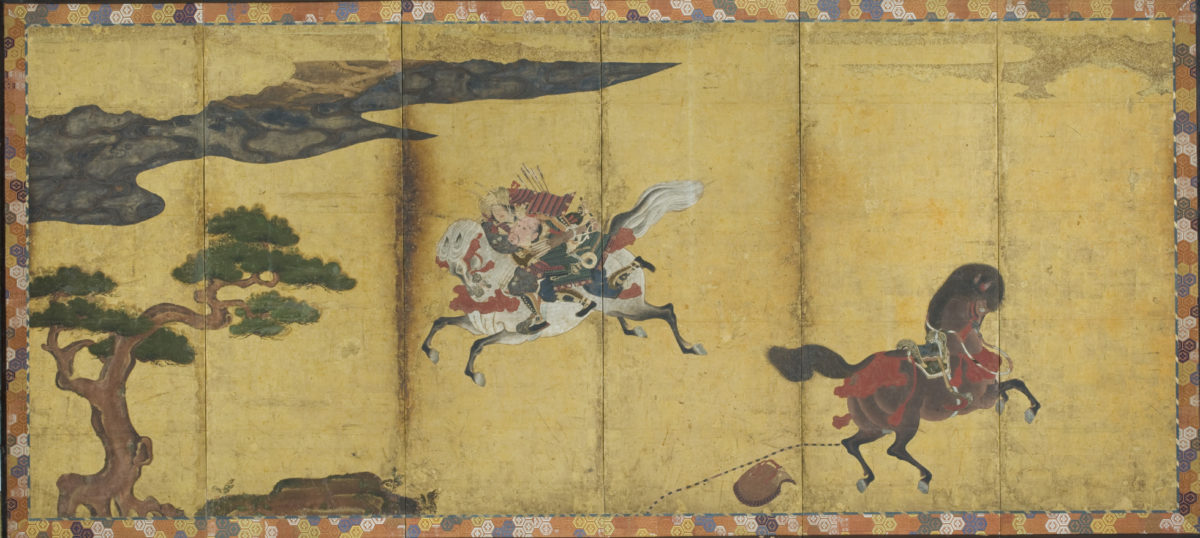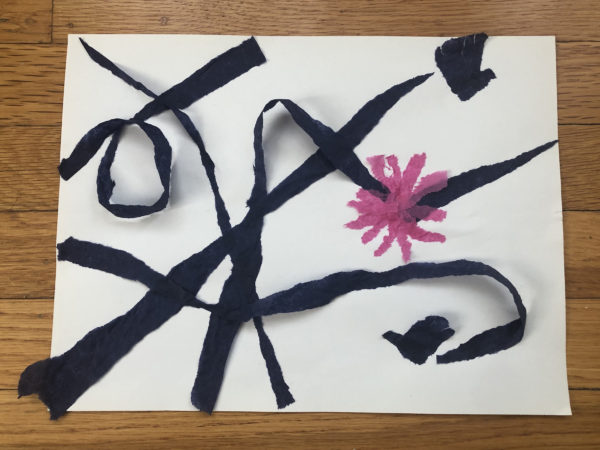Activity
Code of the Samurai in Art and Literature
Students will view representations of literary epics, read related excerpts, and discuss how those scenes exemplify the code of the samurai.

The first man across the Uji River and the battle of Awazugahara, from The Tale of the Heike, one of a pair, 1650–1700.
Common Core Standards: RIT 6.2: Determine a central idea of a text and how it is conveyed through particular details; provide a summary of the text distinct from personal opinions or judgments. RIT 6-8.3: Analyze in detail how a key individual, event, or idea is introduced, illustrated, and elaborated in a text.
Content Standards (California):
VPA/VA 6.3.1: 3.1 Research and discuss the role of the visual arts in selected periods of history, using a variety of resources (both print and electronic). VPA/VA 6.5.2: Research how traditional characters (such as the trickster) found in a variety of cultures past and present are represented in illustrations. VPA/VA 7.3.1: Research and describe how art reflects cultural values in various traditions throughout the world.
Materials:
Worksheets: Student Worksheet; Artwork: Screen Painting Battles at Ichi-no-tani and Yashima; The First Man Across the Uji River; Scene from The Storehouse of Loyalty
Procedure:
- Provide each student with the Student Worksheet.
- Ask students to brainstorm characteristics of samurai behavior (courage, loyalty, honor, military skill)
- Ask students to brainstorm characteristics of samurai behavior (courage, loyalty, honor, military skill)
- Show artwork Battles at Ichi-no-tani and Yashima and First Man Across the Uji River from The Tales of the Heike.
- Ask the students to describe what they see. Summarize The Tales of the Heike. (See artwork descriptions and contextual essays for an overview in “Related Resources” below.) Ask:
- Why might this story have been popular on screens in the home of a daimyo or samurai? (gold adds light, screen could divide room)
- How do you think this screen might have looked and functioned in the context of a room? (The screen painting was purposely made to look very beautiful, with rich colors and a gold background. Some samurai lords wished to appear wealthy, so they commissioned paintings that would project status and wealth.)
- What do we learn about samurai behavior from the story as it is shown in the painting? (courage, discipline, loyalty, acts of heroism, appreciation of beauty)
- What do we NOT see about war in the painting? (blood, graphic death)
- Have students add supporting evidence of samurai behavior from the artwork and description of Tales of the Heike to their worksheet.
- Ask the students to describe what they see. Summarize The Tales of the Heike. (See artwork descriptions and contextual essays for an overview in “Related Resources” below.) Ask:
- Show artwork The First Man Across the Uji River, from The Tale of the Heike.
- Have students observe if other models of samurai behavior are evident in The First Man Across the Uji River from The Tales of the Heike.
- Have students read the excerpt about Tomoe Gozen from The Tale of the Heike.
- Discuss how Tomoe’s story exemplifies the code of the samurai. Add examples to the student worksheet.
- Show the Scene from The Storehouse of Loyalty.
- Have students read the excerpt from Chushingura and view Scene from The Storehouse of Loyalty. Have students complete their worksheets.
- Discuss the action of the figures in the painting.
- Discuss the concept of ronin, or masterless samurai. Samurai felt great honor and loyalty to their master. The story of Chushingura tells about a group of samurai who lost their master and avenged his death. Look at the picture and read the accompanying excerpt from Chushingura.
- How does the action of the men in this print, which shows such a story, express the deep loyalty that dishonored samurai would have felt? (angry faces, raised weapons)
- How do their actions reflect the code of the samurai? (acting as a group, showing loyalty and obedience to a leader)
Further Research:
Find examples from other primary sources, such as Miyamoto Musashi’s The Book of Five Rings, that state how samurai should behave. Then, find a filmmaker or artist who has been inspired by samurai. Compare and contrast the literary descriptions with examples of how samurai are represented in popular culture. Consider themes such as group loyalty versus the lone hero. Take a position and write a persuasive essay arguing why your example is successful or unsuccessful at representing samurai with historical accuracy. Possible sources are: films by Quentin Tarantino, Akira Kurosawa, etc. such as The Last Samurai and Ran.





